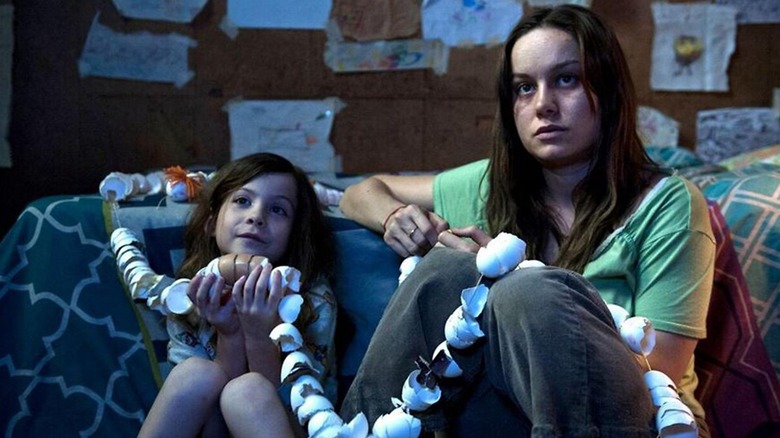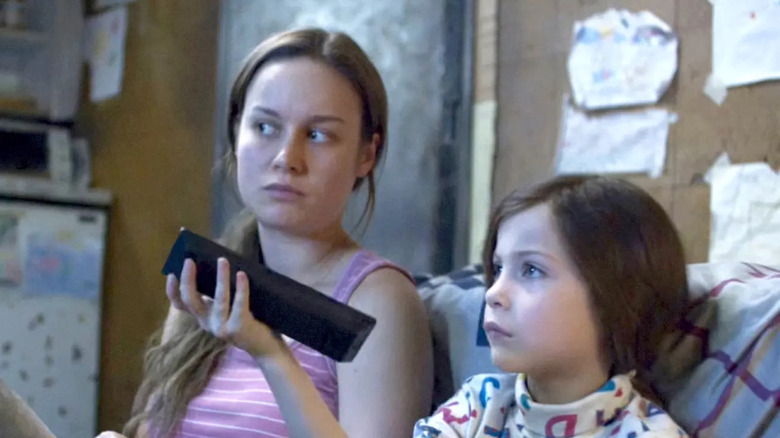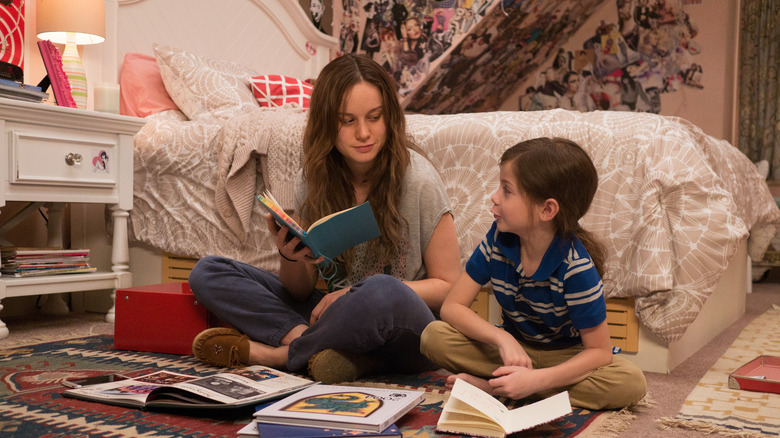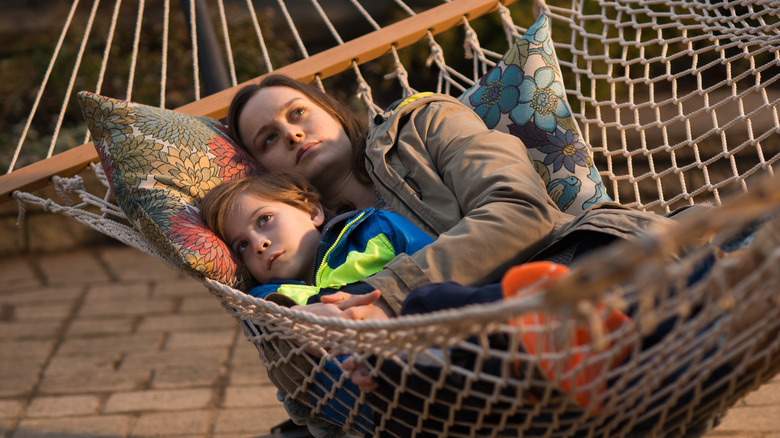Is Room With Brie Larson Actually Based On A True Story?
How do you follow up a movie like "Frank," a quirky musical comedy about the lead singer of an avant garde band who has spent years wearing a large papier-mâché head? In Lenny Abrahamson's case, you direct "Room," a tender yet harrowing story about a mother and her young son held in captivity for years by a sexual predator.
The two films perhaps aren't as different as that brief synopsis suggests. Irish filmmaker Abrahamson has often told stories about outsiders with a different perspective on the world throughout his career. As he once told Far Out:
"A lot of my work is about people who are stepping away from society. I think it's fair to say that I look at those marginalized, or feel different, in society. It helps us to empathize with the characters if they're outsiders looking in."
"Frank" and "Room" share this theme. Once Frank (Michael Fassbender) finally takes off his mask, he must come to terms with reality without his protective shield; when Joy (Brie Larson) and Jack (Jacob Tremblay) figure out a way to escape their captor, the boy's whole life is turned upside down by contact with the big, wide world beyond the four walls he has grown up in.
Both stories also have a basis in real life. For "Frank," Abrahamson's jumping-off point was the bizarre character of Frank Sidebottom, the eccentric giant-head-wearing alter ego of Chris Sievey, who became a cult figure in the UK in the '80s. "Room," on the other hand, tacked a lot closer to its source of inspiration, albeit one that its original author sought to distance herself and her characters from.
So what happens in Room again?
"Room" opens on the morning of Jack's (Jacob Tremblay) fifth birthday as he greets all the objects in his titular prison as friends. While his mother Joy (Brie Larson) has been held captive in the grubby soundproofed shed for seven years since her abduction, to him it is his whole world. She tries her best to shield her son, fathered by the man who has entrapped and routinely sexually assaults her, from the horrific reality of their situation by telling him that the outside world only exists on TV and bedding him down in the closet before "Old Nick" pays his nightly visit. She bravely acquiesces to the demands of her captor, and he provides them with the bare essentials they need to survive.
Things sound grim for Joy and Jack when Old Nick reveals that he has lost his job and might not be able to afford to keep them much longer. To make matters worse, he cuts off the electricity to punish them after Jack comes into contact with his biological father for the first time. Joy decides it is time to make an escape attempt and tries to get Jack onboard by telling him the world beyond their walls is real, causing him much distress. Nevertheless, he goes along with the plan to feign illness so they can escape, and they are returned to Joy's family while Old Nick is arrested.
Freedom proves difficult for them both, however. Jack struggles to adjust to his new life while Joy suffers from depression and the merciless media attention. It takes a near-death incident for Joy and a final visit to Room to help them begin afresh.
The horrific true story that inspired Room
"Room" treats its tough subject with utmost sensitivity. It is strongest in the first half when Lenny Abrahamson and cinematographer Danny Cohen find ingenious ways to make the tiny space visually interesting, helped by the magical-realist touch of Jack's optimistic affection for his confines and every object in it. Brie Larson and Jacob Tremblay's performances are wonderfully naturalistic, and Larson deservedly won an Oscar for her portrayal of a traumatized mom who still manages to create a life for her child in dire circumstances. Also key to the film's success is the screenplay by Emma Donoghue ("The Wonder"), adapting her own novel for the screen and receiving an Oscar nomination for her tactful work.
Prior to its publication, Donoghue's book prompted whispers of sensationalism as it was rumored to be based on the notorious Elisabeth Fritzl case that emerged to great media interest a few years earlier. The author counteracted these concerns by explaining that her story was "triggered" by Fritzl's ordeal rather than directly drawing from it (via The Guardian). As the mother of a toddler herself, her imagination was captured by the experience of Felix Fritzl, the young boy is the case who had spent his entire life in a dungeon under his incestuous father's house.
If the situation endured by Joy and Jack is terrible, the facts of the Fritzl case are even more horrendous (via Spiegel). Austrian teenager Elisabeth Fritzl was lured into the basement of her family home by her father Josef, who then imprisoned her for the next 24 years of her life. He sexually assaulted her on a regular basis, fathering seven children, one of whom died without ever seeing sunlight. The crime was carefully calculated; having first abused her at the age of 11, Josef spent five years extending the basement for the purpose of holding her captive.
Room focuses on the victims rather than the perpetrator
Josef Fritzl covered his tracks by telling his wife and the authorities that Elisabeth ran away to join a cult, forcing her to write letters to back up the story. When room in the basement got scarce, he even integrated three of the children fathered with his daughter into his family with his wife and "upstairs" kids (via Spiegel).
The ordeal of Elisabeth and her three surviving "downstairs" children came to an end when the eldest, Kerstin, then aged 19, became gravely ill and Josef felt obliged to take her to hospital. Doctors were suspicious of their peculiar new patient and reported her, prompting the police to reopen Elisabeth's missing person case. Their investigations eventually pushed Josef out into the open; in a last bid to maintain his ruse, he took Elisabeth to visit Kerstin in hospital, where the police picked them up and learned the full story.
After the horrors of Josef's purpose-made dungeon, Elisabeth and her "downstairs" children required medical care and therapy but still managed to start semi-normal lives. Albert Reiter, of the Amstetten State Hospital, said of Elisabeth: "I have rarely seen such a strong woman. I wouldn't be surprised if she had superhuman powers."
Emma Donoghue said she wanted "Room" to be about "how a woman could create normal love in a box" rather than give Old Nick any attention (via The Guardian). That was the right choice, because we already have plenty of movies and true crime shows that often profile criminals like him and Josef Fritzl while treating the victims as side characters in their own story. By focusing on a resilient mother and her imaginative child, both the book and the film celebrate love and unbreakable human spirit, leaving the ghastly monster who inspired them in the dungeon of history where he belongs.



